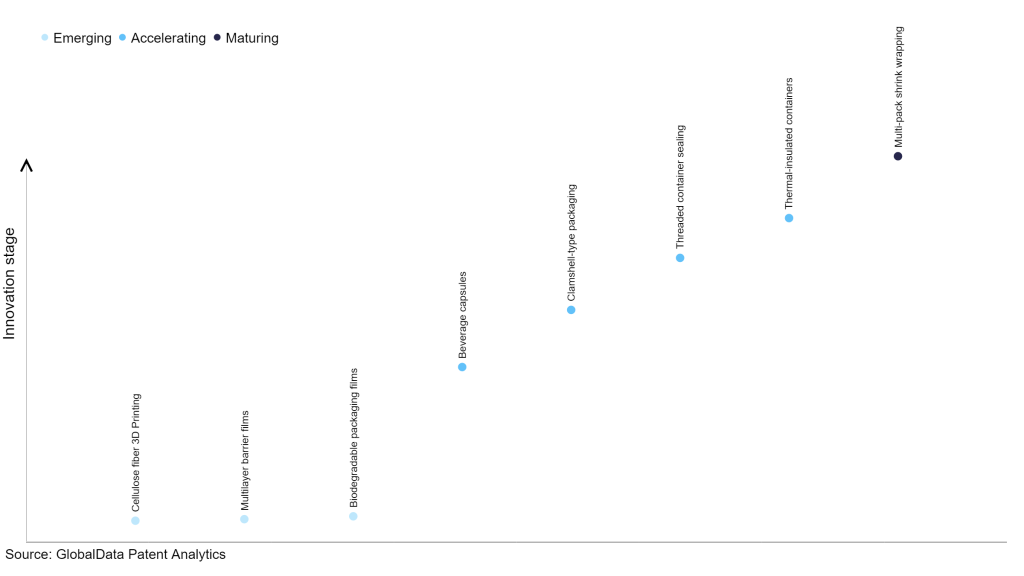The packaging industry continues to be a hotbed of patent innovation. Activity is driven by light weight, sustainability, smart packaging, convenience, and ease of handling and the growing importance of technologies such as artificial intelligence, 3D printing, and nano technology. In the last three years alone, there have been over 18,000 patents filed and granted in the packaging industry, according to GlobalData’s report on Innovation in packaging: waterproof organic paper. Buy the report here.
However, not all innovations are equal and nor do they follow a constant upward trend. Instead, their evolution takes the form of an S-shaped curve that reflects their typical lifecycle from early emergence to accelerating adoption, before finally stabilizing and reaching maturity.
Identifying where a particular innovation is on this journey, especially those that are in the emerging and accelerating stages, is essential for understanding their current level of adoption and the likely future trajectory and impact they will have.
30+ innovations will shape the packaging industry
According to GlobalData’s Technology Foresights, which plots the S-curve for the packaging industry using innovation intensity models built on over 83,000 patents, there are 30+ innovation areas that will shape the future of the industry.
Within the emerging innovation stage, cellulose fiber 3D printing, multilayer barrier films, and biodegradable packaging films are disruptive technologies that are in the early stages of application and should be tracked closely. Beverage capsules, clamshell-type packaging, and threaded container sealing are some of the accelerating innovation areas, where adoption has been steadily increasing. Among maturing innovation areas are thermal-insulated containers and multi-pack shrink wrapping, which are now well established in the industry.
Innovation S-curve for the packaging industry

Waterproof organic paper is a key innovation area in packaging
Waterproof organic paper refers to a type of paper that has been treated or coated to become resistant to water absorption. The treatment or coating prevents water from penetrating the paper fibers, making it suitable for applications where water resistance is required.
GlobalData’s analysis also uncovers the companies at the forefront of each innovation area and assesses the potential reach and impact of their patenting activity across different applications and geographies. According to GlobalData, there are 60 companies, spanning technology vendors, established packaging companies, and up-and-coming start-ups engaged in the development and application of waterproof organic paper.
Key players in waterproof organic paper – a disruptive innovation in the packaging industry
‘Application diversity’ measures the number of applications identified for each patent. It broadly splits companies into either ‘niche’ or ‘diversified’ innovators.
‘Geographic reach’ refers to the number of countries each patent is registered in. It reflects the breadth of geographic application intended, ranging from ‘global’ to ‘local’.
Patent volumes related to waterproof organic paper
Source: GlobalData Patent Analytics
Stora Enso is one of the leading patent filers in waterproof organic paper. Some other key patent filers in the space include International Paper, delfortgroup, and Daikin Industries. Unilever unveiled a fresh packaging approach for its Carte d’Or ice cream line in Italy. The container and its cover are fashioned entirely from renewable fibers certified by PEFC, boasting a biodegradable barrier coating. The innovation renders the packaging waterproof, making it well-suited for housing ice cream. The Carte d’Or packages are manufactured by Seda Packaging Group in Naples, employing Cupforma Natura, a material developed by Stora Enso.
In terms of application diversity, Stora Enso leads the pack, while International Paper and Daikin Industriesstood in the second and third positions, respectively. By means of geographic reach, Clariant held the top position, followed by Yagna and delfortgroup.
Waterproof organic paper will find increased adoption in the coming years, as the packaging industry is under pressure to adopt sustainable practices. Waterproof organic paper can be used in packaging for various products, including food, cosmetics, and personal care items, offering a waterproof solution that is also biodegradable.
To further understand the key themes and technologies disrupting the packaging industry, access GlobalData’s latest thematic research report on Packaging.
Data Insights
From

The gold standard of business intelligence.
Blending expert knowledge with cutting-edge technology, GlobalData’s unrivalled proprietary data will enable you to decode what’s happening in your market. You can make better informed decisions and gain a future-proof advantage over your competitors.



